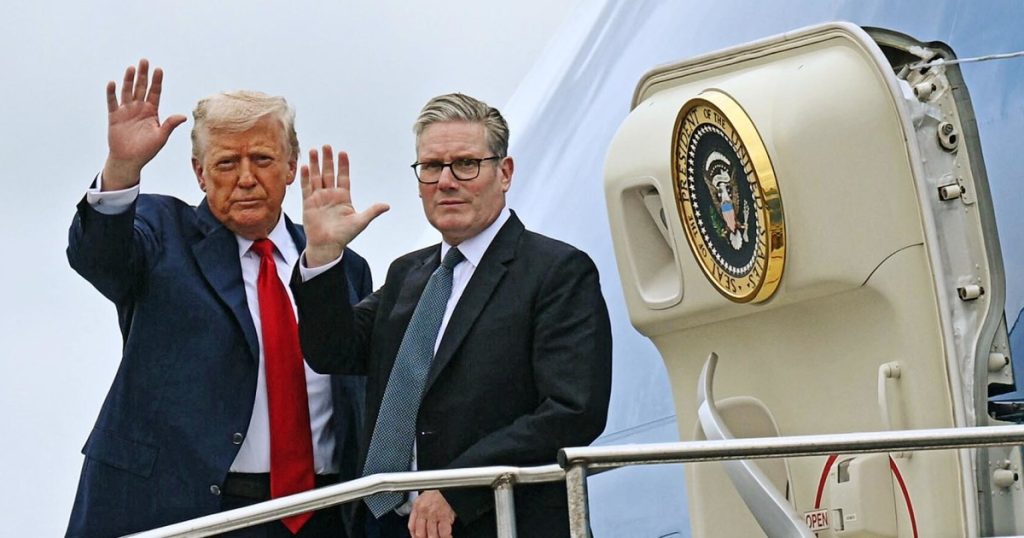Trump’s Tech Tango: From Social Media Spats to AI Ambitions
Former President Donald Trump’s recent interactions with technology have once again placed him at the center of a digital whirlwind. During a meeting with British Prime Minister Keir Starmer, Trump issued a veiled warning against any potential “censorship” of his social media platform, Truth Social, by the UK’s new online safety law aimed at protecting children. While delivered with a smile, the remark underscores Trump’s ongoing battle against content moderation efforts, echoing previous clashes with European regulations. This stance aligns with his administration’s historical skepticism towards such laws, even reportedly raising concerns during trade negotiations.
Meanwhile, Trump’s foray into the realm of artificial intelligence has sparked both intrigue and outrage. His recently unveiled “action plan” for AI dominance, perceived by some as overly favorable to Big Tech, has drawn sharp criticism from within his own base. Figures like Rep. Marjorie Taylor Greene and Steve Bannon have voiced their disapproval, highlighting the internal divisions within the MAGA movement regarding the president’s tech-centric strategy. This friction underscores the complex interplay between Trump’s populist appeal and his embrace of technologies often associated with the very establishment he critiques.
The AI Landscape: From Chatbot Companions to Regulatory Razors
The rise of artificial intelligence continues to reshape the technological landscape, raising both exciting possibilities and unsettling concerns. OpenAI CEO Sam Altman’s recent warning about the potential legal vulnerability of ChatGPT conversations highlights the ethical and legal dilemmas surrounding AI’s increasing integration into our lives. The question of whether interactions with AI chatbots should be afforded the same legal protections as conversations with therapists, doctors, or lawyers underscores the evolving legal framework required for this new technological frontier.
Simultaneously, a disturbing trend has emerged, with teenagers increasingly turning to AI chatbots for friendship and advice on serious matters, often bypassing human interaction. This reliance on artificial companions raises concerns about the potential social and emotional implications of substituting AI for real-world relationships, particularly during formative adolescent years.
The security of online platforms also remains a critical concern. The recent hacking of Tea, an app designed as a safe space for women, exposed vulnerabilities in even specialized platforms. The breach, which compromised thousands of images, including verification photos and government IDs, underscores the ongoing challenges of maintaining user privacy and security in the digital age.
Navigating the Intersection of Technology and Politics
The intertwining of technology and politics continues to shape the regulatory landscape, with significant implications for both industry and society. A recent report suggests that Boeing may have escaped significant repercussions for a series of high-profile catastrophes due to its close ties with the Trump administration. This raises questions about the influence of political connections on corporate accountability and the potential for regulatory capture.
On the regulatory front, Trump’s administration has championed the use of AI tools to streamline federal regulations, with the stated goal of cutting regulations by half. This aggressive deregulatory agenda, facilitated by AI, has drawn criticism from those concerned about the potential erosion of important safeguards. Meanwhile, liberal think tank Third Way has proposed an alternative AI strategy for Democrats, emphasizing innovation while mitigating the potential societal harms of unchecked technological advancement.
The use of technology for malicious purposes continues to pose a threat. The sentencing of an Arizona woman for her role in an identity theft scheme involving North Korean hackers highlights the global nature of cybercrime and the exploitation of digital identities for illicit gain.
The Future of Tech Policy: Balancing Innovation and Responsibility
The intersection of technology and politics presents a complex challenge for policymakers. Balancing the need for innovation with the imperative to protect individuals and society from potential harms requires a nuanced and forward-thinking approach. The ongoing debate surrounding AI regulation, content moderation, and data privacy underscores the urgency of developing robust legal frameworks and ethical guidelines to navigate this rapidly evolving landscape.
As AI becomes increasingly integrated into various sectors, from transportation to government operations, the need for responsible development and deployment becomes paramount. Addressing issues such as algorithmic bias, data security, and the potential displacement of human workers will be crucial for ensuring that AI benefits society as a whole.
Furthermore, fostering international cooperation will be essential to combatting cybercrime and addressing the global challenges posed by emerging technologies. The case of the Arizona woman involved in the North Korean identity theft scheme highlights the need for cross-border collaboration to effectively address these transnational threats.
The future of technology policy hinges on a collaborative effort between governments, industry, and civil society. By fostering open dialogue, promoting responsible innovation, and prioritizing ethical considerations, we can harness the transformative power of technology while mitigating its potential risks. The challenges are significant, but the opportunity to shape a future where technology serves humanity remains within our grasp.


